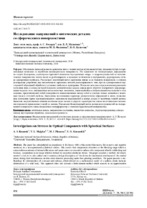| dc.contributor.author | Козерук, А. С. | |
| dc.contributor.author | Мальпика, Д. Л. | |
| dc.contributor.author | Филонова, М. И. | |
| dc.contributor.author | Кузнечик, В. О. | |
| dc.coverage.spatial | Минск | ru |
| dc.date.accessioned | 2019-10-23T07:02:24Z | |
| dc.date.available | 2019-10-23T07:02:24Z | |
| dc.date.issued | 2019 | |
| dc.identifier.citation | Исследование напряжений в оптических деталях со сферическими поверхностями = Investigations on Stresses in Optical Components with Spherical Surfaces / А. С. Козерук [и др.] // Наука и техника. – 2019. – № 5. – С. 416-421. | ru |
| dc.identifier.uri | https://rep.bntu.by/handle/data/58168 | |
| dc.description.abstract | Обоснована целесообразность крепления линз с тонким центром (двояковогнутых, плосковогнутых и отрицательных менисков) за нерабочую цилиндрическую поверхность. Это исключает их температурную деформацию на стадии блокировки, являющуюся причиной появления неустранимых микро- и макропогрешностей на исполнительных поверхностях детали после ее разблокировки, и вызывает астигматизм в изображении, формируемом опти- коэлектронным прибором. Рассмотрен эластичный метод крепления линзы за ее боковую поверхность и описана конструкция устройства для механического крепления деталей рассматриваемого типа при их одновременной двусторонней абразивной обработке в условиях свободного притирания. Изложена методика определения напряженного состояния линз, в основу которой положена математическая модель однородного упругого изотропного деформирования твердого тела, учитывающая метод конечных элементов, заключающийся в аппроксимации исследуемого тела моделью, представляющей собой совокупность взаимосвязанных между собой в узловых точках элементов с конечным числом степеней свободы. Выполнены исследования характера распределения деформаций в линзе, позволившие установить прямо пропорциональную зависимость перемещений в центре детали от величины усилий зажима. Выявлено несущественное влияние величины силы зажима и упругих характеристик линзы на оптимальное положение плоскости приложения усилий ее зажима. Предложен бесконтактный метод контроля погрешностей на полированной поверхности линзы посредством интерферометра с эталонной фронтальной поверхностью. | ru |
| dc.language.iso | ru | ru |
| dc.publisher | БНТУ | ru |
| dc.title | Исследование напряжений в оптических деталях со сферическими поверхностями | ru |
| dc.title.alternative | Investigations on Stresses in Optical Components with Spherical Surfaces | ru |
| dc.type | Article | ru |
| dc.identifier.doi | 10.21122/2227-1031-2019-18-5-416-421 | |
| local.description.annotation | The paper has substantiated an expediency to fix lenses with a thin center (biconcave, flat concave and negative meniscus) to a non-operational cylindrical surface. This avoids their temperature distortion at the blocking stage which is a reason for occurrence of irremovable micro and macro errors on executive surfaces of a component after its unblocking and it causes astigmatism in an image which is formed by an optical-electronic device. The paper considers a method for attachment of a lens to its side surface and it contains a design description of the device for mechanical attachment of the studied lenses during their simultaneous double-sided abrasive processing under free-grinding conditions. The paper presents a methodology for determination of a stressed state in lenses, which is based on a mathematical model of a uniform elastic isotropic deformation of a solid body. This approach takes into account a finite element method which consists in an approximation of a body under study with the help of a model presenting a set of elements with a finite number of freedom degrees which are interrelated at node points. The investigations have been executed with the purpose to study a nature of deformation distribution in a lens which made it possible to establish a directly proportional dependence of displacements in the center of the part on the magnitude of clamping forces. The paper reveals an insignificant influence of a clamping force magnitude and elastic characteristics of a lens on an optimum position of an application plane of its clamping forces. A non-contact method for monitoring errors on a polished lens surface using an interferometer with a reference front surface has been proposed in the paper. | ru |

